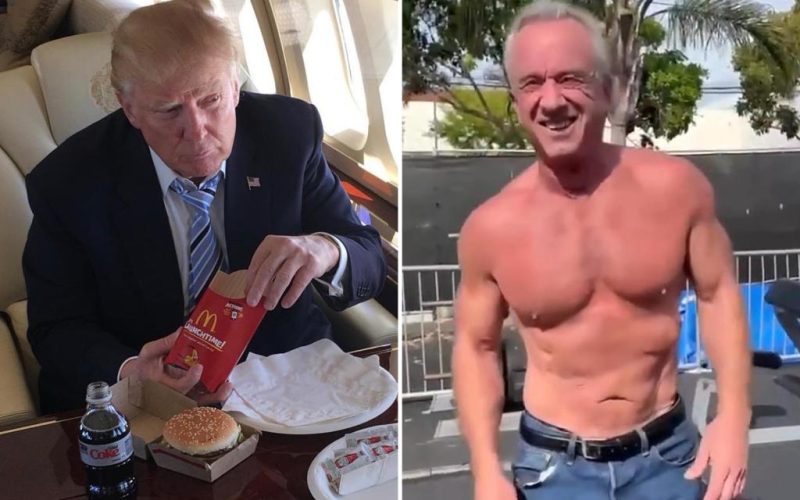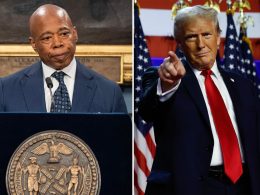President-elect Donald Trump is not shy about his enjoyment of McDonald’s — and his choice to run America’s health apparatus is not shy about critiquing his future boss’ diet.
“The stuff that he eats is really, like, bad,” Health and Human Services Secretary-designate Robert F. Kennedy Jr. told podcaster Joe Polish Monday.
“Campaign food is always bad, but the food that goes onto that airplane is, like, just poison,” the 70-year-old added of the fare on Trump Force One. “You have a choice between — you don’t have the choice, you’re either given KFC or Big Macs. That’s when you’re lucky, and then the rest of the stuff I consider kind of inedible.”
The “rest of the stuff” can be surmised by considering what Trump requested to be served in his box when he attended the Georgia-Alabama college football game Sept. 28: “two Filet-O-Fish sandwiches with cheese from McDonald’s, stadium hotdogs [sic], Domino’s pizza and Diet Coke,” according to AL.com.
RFK Jr. has insisted he has no desire to ban fast food, calling it “part of American culture” in social media posts last month, but he has called for the elimination of some of the key ingredients that make McDonald’s, well, McDonald’s.
Here are the changes the Kennedy scion would push:
No more seed oils
Can you imagine a McDonald’s order without those signature golden, salty fries?
RFK Jr. can, and he wants it to happen.
The 70-year-old, who possesses an incongruous-looking six-pack and is not shy about shirtless workouts, has said he is “against food that has seed oils.”
Seed oils include canola, soybean, and hydrogenated soybean oil — a blend of which is what McDonald’s cooks its fries in.
After Trump made a viral stop at Mickey D’s last month, RFK Jr. stated that the fast food titan should return to its initial practice of cooking the fries in beef fat tallow rather than seed oils.
That method, common at more gourmet burger joints, would give fries a darker color and a meatier taste
“That was good for you. Your body needs that, it makes you healthy,” Kennedy said on Fox News of the tallow method.
“Why aren’t we making it with tallow fat again?”
RFK Jr. also claimed seed oils are “one of the most unhealthy ingredients in foods and the reason they’re in the foods is because they are heavily subsidized,” and cited them as a cause of illnesses like “body-wide inflammation.”
The Kennedy scion has even released “Make Frying Oil Tallow Again” merchandise to drive his message home.
Registered dietician Claire Edgemon told The Post Friday that “cautions” should be applied to the use of both beef tallow and seed oils due to their high calorie count and added that “one nutrient doesn’t make or break health.”
“What is important is overall diet pattern,” Edgemon. “A diet high in minimally processed, whole foods (with an appropriate amount of dietary fat) has been shown to decrease risk of chronic diseases.”
Edgemon also argued that serving sizes are the biggest factor contributing to obesity — rather than the oils food is cooked in.
“Fast food restaurants that use either beef tallow or seed oil are adding calories to the food,” she said. “Eating calories above what is needed on a daily basis is what contributes to obesity. Thirty years ago, when beef tallow was used in the fast-food industry, the serving sizes were smaller.
“There is no one cause that can be identified as driving the obesity epidemic [but] one contributing factor is serving sizes. As serving sizes have increased over the past thirty years, we have seen an increase in obesity.”
Bye-bye, food dye
RFK Jr. has also spoken out against artificial dyes in “junk food” and tied them to lower life expectancy in the US compared to countries like Canada, Germany and Japan.
Trump’s favorite drink is Diet Coke, which contains caramel color — an artificial dye that gives the drink its signature dark brown color, and is made by treating carbohydrates with ammonia-based chemicals.
“If you look at a pack of Froot Loops in this country, it’s all chemical dyes,” Kennedy told podcast host Steve Gruber in September. “Yellow, blue, red dye, which are poison.
“In Canada, across the border, Froot Loops are a different color; they’re all colored by vegetable oils. It’s the same company. Kellogg’s knows how to create safer products that don’t have chemicals in them.”
“It’s not that these foods are poison, but it’s a game of averages,” Toronto-based dietician Andy De Santis told The Post Friday.
“If [fast food is] playing way too big of a role, it displaces other foods that are very important and that are irreplaceable,” he added, noting that a fast food diet will not likely contain vital nutrients found in fish, nuts and beans.
Fluoride-free
Trump’s Diet Coke fixation is so pervasive that Kennedy told Polish Monday that UFC CEO Dana White told him he’s never seen the 45th president “drink a glass of water” in their 20-year relationship.
The 78-year-old Trump is usually pictured sitting with a glass of his favorite carbonated beverage, even on his plane and during meetings with foreign counterparts.
If Trump did drink water though, Kennedy would want there to be no fluoride added, as he’s called for the chemical to be removed from the public water supply.
“The Trump White House will advise all U.S. water systems to remove fluoride from public water,” Kennedy wrote in an X post before the election, claiming that it is “associated” with harmful health effects.
Fluoride treatment of water is decided on a state and municipal level, so it’s doubtful Kennedy would be successful in limiting the presence of the substance that was added to water supply in early 1945 to prevent tooth decay.








